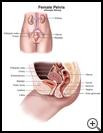
Hysterectomy, Abdominal
What is an abdominal hysterectomy?
An abdominal hysterectomy is a procedure in which the uterus is removed through a cut in the abdomen. The uterus is the muscular organ at the top of the vagina. Babies develop in the uterus, and menstrual blood comes from the uterus. The type of surgery you have to remove the uterus may be one of the following:
- Total hysterectomy: Surgery to remove the uterus and the cervix. The ovaries and fallopian tubes may also be removed.
- Subtotal hysterectomy: Surgery to remove the top part of the uterus (called the fundus), but the cervix is left in place
- Radical hysterectomy: Surgery to remove the uterus (womb), the cervix, and possibly part of the vagina
Some of the problems that may be treated with a hysterectomy are:
- Noncancerous growths in the uterus, called fibroids
- Constant heavy bleeding that has not been controlled with other treatments
- Abnormal growth of uterine tissue outside the uterus (endometriosis) that causes pain or bleeding not controlled with other treatments
- Chronic pelvic pain
- A fallen (sagging) uterus
- Cancer of the cervix or the uterus
How is an abdominal hysterectomy done?
Before the procedure:
- Your healthcare provider will ask you to sign a consent form for the abdominal hysterectomy. The consent form will state the reason why you are having the procedure, what happens during the procedure, and what you may expect afterward.
- There is risk with every treatment or procedure. Talk to your healthcare provider for complete information about whether any of these risks apply to you:
- Anesthesia problems
- Bleeding
- Blood clots
- Infection
- Tell your healthcare provider if you have any food, medicine, or other allergies such as latex.
- Tell your healthcare provider if you are taking any medicines, including nonprescription drugs, herbal remedies, or recreational or illegal drugs.
- You will have a small tube (IV catheter) inserted into a vein in your hand or arm. This will allow medicine to be given directly into your blood and to give you fluids, if needed.
During the procedure:
- You may be given a sedative through your IV to help you to relax.
- You will be given medicines to prevent pain during your surgery. These may include:
- Regional anesthesia numbs a large area of your body. Depending on the medicine, you may be awake or asleep during the procedure.
- General anesthesia relaxes your muscles and puts you into a deep sleep. It also keeps you from remembering the operation. While you are asleep, you will have a tube in your throat to help you breath and to make sure you are getting enough oxygen. The tube may be removed before you wake up after the surgery.
- You may have a small tube (catheter) placed into your bladder to drain and measure urine.
- Your surgeon will determine the best surgery for you. Depending on the reason you need the hysterectomy, your provider may perform:
- Abdominal hysterectomy: Surgery to remove the uterus through a large cut on the lower abdomen
- Laparoscopic hysterectomy: Surgery to remove the uterus through several small cuts in the lower abdomen. A thin tube with a light and tiny camera called a laparoscope is placed through one of the cuts to help your provider see the uterus.
- Lymphectomy: Surgery to remove lymph nodes near the uterus if you have cancer to check if the cancer has already spread
- The top of the vagina is stitched closed so that a hole into the abdomen is not left open.
After the procedure:
- You will be checked often by nursing staff.
- Your blood oxygen level will be monitored by a sensor that is attached to your finger or earlobe.
- Your heart rate, blood pressure, and temperature will be checked regularly.
- There may be a dressing on your belly. The dressing will be checked and changed by your provider or the nursing staff as needed.
- Your provider may prescribe medicine to:
- Treat pain
- Treat or prevent an infection
- Soften your bowel movements to reduce straining
- Help relieve the symptoms of menopause if your ovaries were removed
- Your provider may recommend other types of therapy to help relieve pain, other symptoms, or side effects of treatment.
What can I do to help?
- You will need to tell your healthcare team if you have new or worsening:
- Belly pain or cramp
- Heavy vaginal bleeding
- Dizziness or lightheadedness
- Swelling, redness, or pain in your legs
- Chest pain
- Shortness of breath
- Trouble emptying your bladder
- Change in bowel habits, such as pain, mucus, diarrhea, constipation
- Redness, swelling, pain, warmth, or drainage from your surgical wound
- Fever, chills, or muscle aches
- Ask questions about any medicine, treatment, or other information that you do not understand.
How long will I be in the hospital?
How long you stay in the hospital depends on many things, such as your general health and why you needed the procedure. The average amount of time to stay in the hospital after an abdominal hysterectomy is 2 to 3 days. Talk with your provider about how long your stay may be.
Developed by RelayHealth.
Acute Care Advisor 2016.4 published by RelayHealth.
Last modified: 2016-02-08
Last reviewed: 2016-01-19
Last modified: 2016-02-08
Last reviewed: 2016-01-19
This content is reviewed periodically and is subject to change as new health information becomes available. The information is intended to inform and educate and is not a replacement for medical evaluation, advice, diagnosis or treatment by a healthcare professional.
Copyright © 2016 RelayHealth, a division of McKesson Technologies Inc. All rights reserved.

